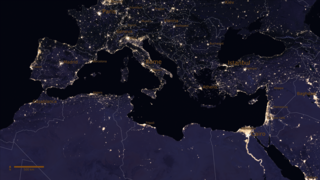Universe
ID: 30020
Bound together by gravity, galaxies are large collections of stars and stellar remnants that coexist with interstellar gas and dust (as well as dark matter). On a clear night, our galaxy—the Milky Way—can be seen by the naked eye, but because our eyes cannot distinguish the individual stars that make up the glowing band of light, it appears “milky.” Infrared telescopes, however, see with different “eyes,” capable of detecting various wavelengths (outside the visible range) that provide unprecedented views of our Galaxy and beyond. This not-so-milky image of the Milky Way—nearly free of the obscuring effects of interstellar dust—was made with data from two highly automated 1.3 m ground-based telescopes used during the Two Micron All Sky Survey (2MASS) project. 2MASS is a joint project of the University of Massachusetts in Amherst and the Infrared Processing and Analysis Center at the California Institute of Technology. 2MASS has uniformly scanned the entire sky in three near-infrared bands, using two highly-automated 1.3-meter telescopes, one at a northern hemisphere facility and the other in a southern hemisphere facility. Images such as this, allow scientists to gain a better understanding of the structure of our Galaxy and the universe.

The Not-So "Milky" Milky Way

For More Information
Credits
Mark Malanoski (GST): Lead Animator
Leann Johnson (Global Science and Technology, Inc.): Project Support
Eric Sokolowsky (Global Science and Technology, Inc.): Project Support
Leann Johnson (Global Science and Technology, Inc.): Project Support
Eric Sokolowsky (Global Science and Technology, Inc.): Project Support
Please give credit for this item to:
NASA's Goddard Space Flight Center
NASA's Goddard Space Flight Center
Short URL to share this page:
https://svs.gsfc.nasa.gov/30020
This item is part of this series:
Hyperwall
Keywords:
SVS >> HDTV
SVS >> Hyperwall
SVS >> Astronomy >> Milky Way
NASA Science >> Universe
SVS >> Presentation
https://svs.gsfc.nasa.gov/30020
This item is part of this series:
Hyperwall
Keywords:
SVS >> HDTV
SVS >> Hyperwall
SVS >> Astronomy >> Milky Way
NASA Science >> Universe
SVS >> Presentation











